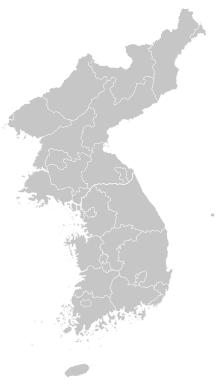
Back معركة إنتشون Arabic اینچئون دؤیوشو AZB Битка при Инчон Bulgarian Emgann Incheon Breton Batalla d'Inchon Catalan Vylodění v Inčchonu Czech Operation Chromite German Batalla de Incheon Spanish Inchoni lahing Estonian نبرد اینچئون Persian
| Battle of Inchon | |||||||
|---|---|---|---|---|---|---|---|
| Part of the Korean War | |||||||
 Four tank landing ships unload men and equipment on Red Beach one day after the amphibious landings on Incheon. | |||||||
| |||||||
| Belligerents | |||||||
|
| |||||||
| Commanders and leaders | |||||||
| |||||||
| Units involved | |||||||
|
| ||||||
| Strength | |||||||
|
About
| ||||||
| Casualties and losses | |||||||
|
809 wounded 2 cruisers damaged 3 destroyers damaged 1 LST lost and 3 damaged 1 aircraft destroyed |
| ||||||
Location within Korea | |||||||
The Battle of Inchon (Korean: 인천 상륙 작전; Hanja: 仁川上陸作戰; RR: Incheon Sangnyuk Jakjeon), also spelled Battle of Incheon, was an amphibious invasion and a battle of the Korean War that resulted in a decisive victory and strategic reversal in favor of the United Nations Command (UN). The operation involved some 75,000 troops and 261 naval vessels and led to the recapture of the South Korean capital of Seoul two weeks later.[9] The code name for the Inchon operation was Operation Chromite.
The battle began on 15 September 1950 and ended on 19 September. Through a surprise amphibious assault far from the Pusan Perimeter that UN and Republic of Korea Army (ROK) forces were desperately defending, the largely undefended city of Incheon was secured after being bombed by UN forces. The battle ended a string of victories by the North Korean Korean People's Army (KPA). The subsequent UN recapture of Seoul partially severed the KPA's supply lines in South Korea.
The UN and ROK forces were commanded by General of the Army Douglas MacArthur of the United States Army. MacArthur was the driving force behind the operation, overcoming the strong misgivings of more cautious generals to a risky assault over extremely unfavorable terrain. The battle was followed by a rapid collapse of the KPA; within a month of the Incheon landing, the Americans had taken 135,000 KPA troops prisoner.[10]
- ^ Halberstam 2007, p. 302
- ^ attached to the US Army 7th Infantry Division
- ^ attached to the USMC 1st Marine Division
- ^ attached to the US Army 7th Infantry Division and the USMC 1st Marine Division
- ^ attached to the US Army 7th Infantry Division
- ^ attached to the US Army 7th Infantry Division
- ^ Utz, Curtis (2000). Assault from the Sea: The Amphibious Landing at Inchon. Washington: Naval Historical Center, Dept. of the Navy. p. 24. ISBN 0945274270.
- ^ Hoyt 1984, p. 11. They did not anticipate any air opposition for, as far as intelligence knew, the North Koreans had only nineteen planes left.
- ^ The Independent, 16 September 2010, p. 35 reporting on a 60th-anniversary re-enactment.
- ^ Stueck, William W. (2002), Rethinking the Korean War: A New Diplomatic and Strategic History, Princeton, NJ: Princeton University Press, ISBN 978-0691118475 Page 202.
© MMXXIII Rich X Search. We shall prevail. All rights reserved. Rich X Search
